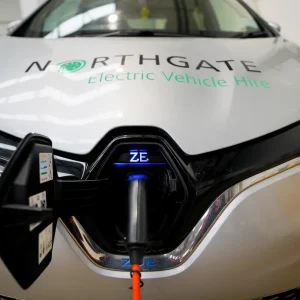Last year’s improvements to Chevin’s Fleetwave system saw it, after two years of being Highly Commended, make the step up to win the 2014 BusinessCar Techie Award in the fleet management category.
The Derbyshire-based company, formed in 1990, first launched Fleetwave in 2001, and won the 2014 Techie for version 2.2, which has recently been superseded by 2.3, with 2.4 coming during 2015.
“What we’ve done with Fleetwave in the last 12-18 months is write a lot – work on the foundations rather than the front end,” Chevin managing director Ashley Sowerby tells BusinessCar. “A lot [has happened] behind the scenes to provide a stronger base for what we’re building; now we’re focusing on the front end and offering much more information at the appropriate level.”
Sowerby emphasises the flexibility of the Fleetwave system, although he says that means there isn’t a straightforward standard client base.
“We don’t have a typical client. It would be good if we did because then we could focus on that,” he says. “If you look at our projects – public, private, law enforcement, non-government organisation fleets – there isn’t a conventional group.”
That flexibility is described as like Lego by Sowerby. “We have all these different elements and we can build you what you want – one client wants an airport so we build them an airport, another wants a fire station so we build them a fire station,” he explains. “What customers are buying is 24 years of experience. They don’t want us turning up with a bucket of bricks and saying what shall we build; they want our experience, and then they may configure extra elements.”
The company runs customer user groups several times a year to garner customer feedback, as well as educating clients on the latest updates. “One of the questions we always ask at these meetings is, ‘what are you still doing in Excel’?”, says Chevin’s boss, highlighting the recent addition of pivot table (a data summarisation tool) reporting found on spreadsheets.
Wider technology also has an impact, with Sowerby pinpointing the likes of Facebook and Google from a functionality perspective. “How is the user experience and what can we learn from that?” he asks. “The ideal for me is to get to the point where we don’t have to train people how to use Fleetwave; no one has ever been trained how to use Facebook, but the user experience is such that it’s quite obvious where to go.”
Part of that user education is the Chevin Academy tool launched last year in the 2.2 upgrade, a series of videos to educate users in elements such as how to build reports.
“It comes back to the concept that they shouldn’t have to phone Chevin to find out how to do something – it should be there and the videos help that,” says Sowerby. The company’s training guide is also framed in a mock-up of the user’s individual system. “The training guide is what you see when you go on to the system. It’s a personal view – subtle and low-impact – but raises confidence levels for the user with applications.”
Other 2.2 additions included a tool to highlight vehicles under or over budgets for the month, quarter or year, and a smart vehicle replacement tool to help identify particularly efficient vehicles worth retaining or inefficient ones that should be disposed of, along with replacement recommendations.
Chevin’s growth is mainly coming as a result of contract wins from rivals, rather than new fleets taking on fleet management technology, even though there are still “an awful lot of people” managing their fleets via Excel or using legacy home-grown solutions. Sowerby claims companies are coming Chevin’s way because of the company’s “depth of functionality and ease of use”.
The public sector is seen as a particular area with potential for growth as regulatory and compliance requirement increases and risk management awareness grows, while in the private sector, pressures for suppliers to prove their environmental credentials could become more prevalent.
The 2.3 upgrade that went out late last year added a new data integrity tool that helps pick up errors on data being imported, enhanced visual features, multilingual search capabilities and other functionality improvements.
Looking ahead to 2015, the next update is likely to revolve around mobile applications. “There are lots you can do with the mobile app around inspection sheets and workforce jobs, and a lot more around expenses,” says Sowerby. “The app is probably the big one for us in 2015, especially around mileage and expenses.”
Chevin: A potted history
A management buyout in 1990 gave birth to Chevin, but the change in the role of the web at the beginning of the century really kick-started the firm. “In 2001 the internet was starting to change from being a shop window to an application platform,” says Chevin managing director Ashley Sowerby. “We looked into the existing Roadbase product and whether we could enable it, but six weeks into the project we decided we were trying to shoehorn the wrong technology into the wrong platform.”
Taking itself out of the market for 18 months, Chevin returned with Fleetwave. “Everyone else had a legacy product with a tiny bit of functionality for a web portal, which was a very clunky solution, but Fleetwave immediately enabled us to go into larger fleets and multi-sites,” Sowerby explains. “Suddenly, we climbed the ladder of who we could sell to.”
Chevin opened its US office in 2002, and the US and UK, which also includes Chevin’s Middle Eastern operations, are closely matched in revenue terms. A third bash at Australia proved successful in 2009 with the establishment of Chevin Fleet Solutions Australia, rather than relying on distributors as had been the case with previous attempts, and Fleetwave 2 came along in 2010, described as a”foundation-level rewrite”.
“Fleetwave developed a lot over the period, but at some point you need to flatten and rebuild, and that’s what we did with Fleetwave 2,” says Sowerby. “The performance leap was massive, with a lot more scalability.”
In 2011, Chevin opened its European office in Brussels, and also has operations in various parts of Africa.





